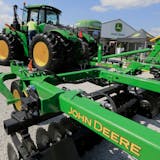Last spring's tornado ripped through north Minneapolis and downed thousands of trees. But critics say that the cleanup in Theodore Wirth Park has done far more damage than the storm.
Those who live near the worst-hit areas said that Minneapolis forestry officials went too far, stripping the park land not only of fallen trees but also of woody debris and brush that support a diverse mix of birds and wildlife. One area, loaded with mature oak, evergreens and brush before the storm, now has a cleaner look. Its remaining trees stand out on a hilly terrain covered with so many wood chips that it looks like snow on a ski run. Across the street, tree stumps are almost all that's left in a bowl-shaped area where tall cottonwoods once swayed.
"Large portions of this area have been converted from an oak forest to a sparsely vegetated state," said Rich Baker, a Golden Valley resident who lives nearby and walks the park trails almost daily. "I think they went way overboard in removing damaged trees."
Baker works for the Minnesota Department of Natural Resources and heads the Golden Valley Environmental Commission, but said he was speaking only for himself.
Minneapolis forestry officials acknowledge that the land looks dramatically different than before the tornado, but said they needed to conduct a thorough cleanup in order to reduce safety risks and potential fire hazards.
Wirth Park, the largest regional park in the Minneapolis system, straddles the border between Minneapolis and Golden Valley but is entirely maintained by the Minneapolis Park and Recreation Board.
Minneapolis forestry director Ralph Sievert said an extensive cleanout was needed because the damage was so vast.
"You had broken tops, and trees upon trees," he said. "It was really thick."



